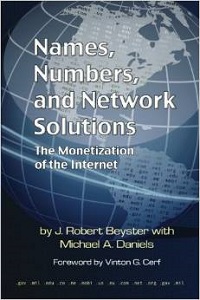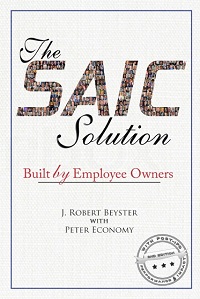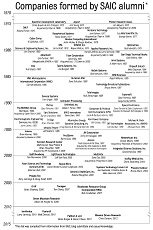Some of our major acquisitions (Bellcore/Telcordia, Network Solutions, etc.) were of companies with cultures quite different than SAIC’s. I’m wondering if you were personally affected by the introduction of these new cultures and, if so, in what ways. Any specific examples come to mind?
Search


Where Have They Gone?
(Click image to read more)
Photos
| www.flickr.com |
Archives
- May 2017
- April 2017
- December 2015
- February 2015
- January 2015
- December 2014
- August 2014
- July 2014
- June 2014
- May 2014
- April 2014
- March 2014
- February 2014
- January 2014
- December 2013
- November 2013
- October 2013
- September 2013
- August 2013
- July 2013
- June 2013
- May 2013
- April 2013
- March 2013
- February 2013
- January 2013
- December 2012
- November 2012
- October 2012
- September 2012
- August 2012
- July 2012
- June 2012
- May 2012
- April 2012
- March 2012
- February 2012
- January 2012
- December 2011
- November 2011
- October 2011
- September 2011
- August 2011
- July 2011
- June 2011
- May 2011
- April 2011
- March 2011
- February 2011
- January 2011
- December 2010
- November 2010
- October 2010
- September 2010
- August 2010
- July 2010
- June 2010
- May 2010
- April 2010
- March 2010
- February 2010
- January 2010
- December 2009
- November 2009
- October 2009
- September 2009
- August 2009
- July 2009
- June 2009
- May 2009
- April 2009
- March 2009
- February 2009
- January 2009
- December 2008
- November 2008
- October 2008
- September 2008
- August 2008
- July 2008
- June 2008
- May 2008
- April 2008
- March 2008
- February 2008
- January 2008
- December 2007
- November 2007
- October 2007
- September 2007
- August 2007
- July 2007
- June 2007
- May 2007
- April 2007
- March 2007
- February 2007
- January 2007
- December 2006
- November 2006
- October 2006
- September 2006
- August 2006
- July 2006
- June 2006
- May 2006
- April 2006
Categories
- Competitiveness (6)
- Employee Ownership (61)
- Energy (24)
- Entrepreneurship (36)
- FED (29)
- Government (43)
- Network Solutions (51)
- P. Economy (1)
- Politics (34)
- SAIC (51)
- SAIC Alumni (17)
- San Diego (100)
- Secret Sauce (1)
- Technology (88)
- The Blog (11)
- The Book (84)
- Uncategorized (20)
Brought to you by:

Subscribe
What is RSS?
Receive email alerts
| M | T | W | T | F | S | S |
|---|---|---|---|---|---|---|
| « May | ||||||
| 1 | 2 | 3 | 4 | 5 | 6 | 7 |
| 8 | 9 | 10 | 11 | 12 | 13 | 14 |
| 15 | 16 | 17 | 18 | 19 | 20 | 21 |
| 22 | 23 | 24 | 25 | 26 | 27 | 28 |
| 29 | 30 | |||||
Recent Posts
- The Legacy of J. Robert Beyster—a Celebration
- An April Tribute to Bob Beyster and SAIC
- J. Robert Beyster Papers at UCSD Special Collections
- Dr. J. Robert Beyster 1924-2014
- In Loving Memory
- A Public Celebration of Bob Beyster’s Life
- Thank You
- Dr. Beyster’s Passing
- Birthday Thanks and Nine Lessons Learned
- 90th Birthday Celebration
Recent Comments
- Jim Russell: Some 45 years ago in early 1972, I flew out to La Jolla and met with Dr. Beyster to decide whether to...
- Edgar Cruz: In the 14 years I served at SAIC, I learned from people who knew Dr. Beyster personally, that employee...
- Paul Hobin: I’ll always remember the awkward, somewhat apologetic explanations for Dr. Beyster’s low pay...
- Steve Purcell: Well said Mr. Berg!! Dr. Beyster left a big imprint on many of us. Best to all and keep on making a...
- Bob Berg: Like so many other thousands of people, my life was incredibly and positively changed by “Dr....

Hi again Bob,
I hope that you are very well. So fine to see your pictures. MA has done a great job on setting up this site and working on the book deal. like the outline of your book. There are two comments that I have. I am not sure that the planetary word will work. If you will be referring to planets around the sun as in SAIC divisions/groups around a coherent center then that may make sense but if it is another meaning I am not quite so sure. On Darwinian, one must be careful of one extreme, namely the problem where a teacher identifies a student as a poor performer and then TREATS the student like a poor performer so that one gets a self-reinforcing dynamic where the teacher rewards the student’s failure and subtly comunicates low expectations. I think it is called the Pygmalion complex in education — lot of research on it exsits!! I’ve learned as a teacher that every student needs someone to believe in them first.
On your question above, there is a huge human resource management literature on why 70% of mergers and acquisitions fail and oddly most retrospective books by executives never address it because most books do not admit mistakes or failures. I hope yours wil lbe an exception since small mistakes in the context of your wonderful achievements can be a learning expeerience for so many people. I can send you or Peter some of this stuff if you want. Til next time, Joseph
Bob:
I worked with both of these companies after they were acquired – both at the senior mgmt level, and at the working level (on joint projects). These were both companies that had different businesses than the rest of SAIC; they helped the rest of us think about what was possible – that there might be more to the world than selling hours. Both of these companies had professional services organizations, but both of them had other businesses (transaction-based or product-based) which really ended up driving their value. I don’t believe that those company’s cultures had any real significant effect on SAIC’s culture, but they did provide an existance proof that SAIC could generate revenue in ways other than timesold. Hopefully, we can remember that as we go forward, because I believe that it will be a critical part of growing the company in the years to come.
I would say, however, that SAIC’s culture had an extreme impact on both of those companies (Bellcore and NSI) – but I think that is true any time that any company is acquired by any one. I remember when you asked me to go over to Bellcore to have them entertain creating a “DMF-like” organization. This was an example of the two cultures hitting each other “head on.” The idea never really “caught on” at Bellcore/Telcordia, except with a handful of folks. I think that part of the reason that they didn’t have the same need for a DMF was that their “divisions” were born with purpose… That is to say, that each organization seemed to have an endorsed mission/purpose, and it was fairly clear to management and employees what role that organization played in the overall company. It made me realize that part of the function of the DMF at SAIC was to help compensate for that lack of mission hierarchy…. to help each division participate in the collective voice that they didn’t have from being part of a more structured entity – and to help them feel a part of the whole.
Rizzi
Joseph Blasi: We really have been using the planetary model in two separate ways. What you refer to in your response happens with the organizational structure, or groups and divisions. However, in addition, the acquisitions and separate operating parts of SAIC are also organized in a planetary model.
Steve Rizzi: The Division Manager’s Forum played a vital role at SAIC as I remember it. It was a way to get the division managers’ unvarnished opinions. It was sort of like an old-fashioned town hall where everyone could have a say. These suggestions were written up and made known to management. These matters were discussed among the managers and many useful actions took place. The traditional management process was hard or impossible to change at NSI or Telcordia since decision making was relegated to a few people in the management staff.
I believe most would agree that Network Solutions was a success story.
However, I believe, frankly, that SAIC “failed†in some regards to Telcordia. I shall never forget my first visit to Telcordia’s “front office†– first I was tremendously impressed with the luxurious and lavish appearance – but then, I said to myself, I wonder what JRB thought when he saw it? On the other hand, that first impression and question pretty much capsulizes why I believe we failed Telcordia. Telcordia was a commercial company, with products to sell, and needed to market them like a commercial products company – that means more lavish front offices, more advertising, and spending money in advance of customer requirements.
You may recall that I wrote a booklet, “How to Win Commercial Business†– you might retrieve a copy and read it – so much of Commercial business depends on relationships. Very different than Govt business!!!
In any consideration of major SAIC Acquisitions, you must address the Boeing Information Services acquisition. The first loss was the incumbency at China Lake in 2001. In my mind, administrative and cultural difference between “SAIC Corporate” and Boeing IS played a big part of this loss.
It seems to me the point that JRB might want to make in his book somewhere, perhaps in the context of acquisitions, is the importance of “congruent culture”. The lack of it is the reason that some acquisitions struggle or are less than expected.
Bob – The Bellcore/Telcordia and Network Solutions cultures were quite different from SAIC. These are good cases to analyze because they were very different, and they had a lasting influence on SAIC.
It might seem logical to attribute the different cultures in each company to their focus on different markets and capabilities. Telcordia markets to telecom service providers, NSI marketed to consumer and enterprises of all sizes, and SAIC markets to government and larger commercial enterprises.
However that would be an over-simplification because each company shared some common markets and customers including communications service providers, large commercial enterprises, and the government. Also, each company has provided some form of professional services and software development or software integration.
What I find most interesting is that these different cultures were defined neither by their markets nor by their offerings. These cultures were defined by their founding mission, organizational ancestry, and their values.
Telcordia’s culture was defined by their heritage mission as the RBOC IT and a telecom technology provider. Telcordia was very good at solving specific technical problems using disciplined engineering processes, almost to the point of being myopic of the bigger picture business problem. Also, Telcordia was governed by a structured top-down management style adopted from the heritage Bell system where decisions on strategy and direction were deliberate and the individual staff naturally would not stray from their specific domain or area of responsibility.
Conversely SAIC’s culture was the defined by the recognition of the importance of the individual, working on problems of importance to the nation. SAIC’s strength has therefore been a “big picture” view of complex or large systems and the program management required to solve the most diverse engineering and technology problems. Unlike Telcordia, SAIC grew up as a decentralized company that would naturally invade the customer at multiple entry points in a “viral-like” fashion. Where Telcordia naturally presented a consistent interface to its customer, SAIC has a culture that requires constant diligence and discipline in order to present a consistent and unified face to the market.
The Network Solutions culture provided contrast to both SAIC and Telcordia as an Internet startup that operated on the opposite end of the cultural spectrum. As with other successful “.com” startups, Network Solutions struggled with the challenges of hyper-growth where operational discipline and business structure perpetually lagged their need for it. A stereo-typical business debate might have involved why they needed to operate the Internet domain name registry in a protected data center rather than under the developers desk.
SAIC, while not being the paragon of operational discipline either, did help save Network Solutions from themselves in sorting out some complicated issues with the government at a key period in their development.
Regarding the impact that SAIC and Telcordia had on each other, it would seem on the surface that SAIC had more impact on Telcordia than Telcordia had on SAIC. For example, SAIC led Telcordia into the government market which became one of their faster growing new markets at one point.
However when you look below the surface you find examples where Telcordia made a lasting impression on SAIC. Examples include the development of Latent Semantic Indexing, developed originally within Telcordia, but exploited in SAIC’s intelligence business. Telcordia also started the Automotive Network Exchange (ANX) which evolved into an important SAIC commercial initiative. And Telcordia became a CMMi level-5 appraised software development shop setting the example for SAIC long before SAIC achieved any CMMi appraisals.
So I would conclude that SAIC, Telcordia and Network Solutions while growing up with very different cultures driven by their respective founding mission and values, did in fact influence each other in permanent and generally positive ways.
I remember when I joined SAIC nearly 25 years ago, I walked into the McLean Tower for my interview and passed by office after office filled not with staff head down reading or writing technical documents, but in groups of 2 or 3 working on white boards arguing the merits of architectures, process charts, and data flow diagrams. These were people passionate, excited, and energetic about problem solving. It was contagious. I wanted to be part of this team. The next week I checked out of the mass mediocrity of John Toups’ Planning Research Corporation and started an interdisciplinary journey I would have found nowhere else. I truly believe I never could have found the diversity of challenges that has allowed me to discover and contribute to four careers inside of SAIC: C4I, security management, global change research, and emergency management domains.
Along the way good managers took a risk on my capabilities and allowed me to pursue new business lines, I was always held accountable, but I was given respect and resources where good judgment was evident. The chance to cross over many disciplines to help solve problems is what I will best remember about the journey – anything was possible if the planning was good. I owe special thanks to Charlie Stringfellow, Charlie Payne, and Dick Smith for allowing me as a young and unknown engineer to stand before our largest client and help solve a communications subsystem design problem. They convinced me that hard work and quality contributions would indeed be recognized and rewarded in SAI.
Later, when I was tasked on a NASA program to help on interagency data management for the US Global Change Research Program, it was an enormous privilege to brief Dr. Beyster directly on the program and to find in his follow-up he mobilized senior managers to get involved in how other SAIC customers and technologies can be brought to serve that grand challenge. Our founder and CEO listened and engaged on a problem area that was at the time no more than a few hundred thousand dollars of research and engineering. I was convinced you (JRB) were committed to national priorities and your actions assured me that executive management was behind the work and that no customer was too small when the problem addressed significant consequences.
Finally, when I received my first stock award for performance, I felt recognized, and I felt a remarkable individual responsibility and personal accountability for our collective reputation – an experience I had nowhere else in industry and probably never will again.
Hello Dr Beyster,
Thank you so much for creating this blog. It’s a wonderful way to reminisce about the good old days of your fine leadership. We sure miss you!
I’d like to respond to your Week 6 query. As a 16 year employee-owner, I remember well the challenges that came with acquiring Bellcore. I worked for Dr. Larry Harris at that time, and I was with him and a handful of others in your La Jolla office watching a huge tv monitor as you and the Bellcore team signed the acquisition contracts in New Jersey. That was quite a moment, which we all toasted with champagne! Soon after, Dr. Harris tasked me with collaborating with the Bellcore training team on several in-house corporate training projects. He specifically told me to do what I could to help them adjust to the “SAIC way.†I was excited and proud to do so. Unfortunately, Dr. Beyster, that never really happened. From the beginning, my training team and Bellcore’s training department clashed at every turn, from debating the merits of employee-ownership to fees and labor rates. At the time of the acquisition, Bellcore was years ahead of us regarding organized, centralized employee training with a department called Learning Services. (SAIC University was then just a glimmer of an idea that a handful of us SAIC training people had.) Because they had well established for-profit in-house departments, they required fee for all of their IWO work, which SAIC finance resented greatly. Other trivial matters included that they resisted traveling to Campus Point, preferring instead that we always meet at their Lisle training facility, which they reminded us at every opportunity was far superior to any conference services SAIC could provide. I was even told many times that San Diego was a cultural waste land compared to the East Coast, without a decent restaurant, newspaper or theatre, and so on. Anyway, we were able to finally complete a joint project, but along the way the idea of collaboration between SAIC training and Learning Services lost a lot of steam. During this period, Learning Services changed leadership twice and lost key personnel. I do have to credit Learning Services, however, for, in my opinion, jump starting us to get SAIC University rolling. When Pat Cataldo was brought on as our Chief Learning Officer, I was thrilled that training at SAIC was finally getting the high level attention it deserved. I worked with Pat several times while he was with us, including inviting him to co-chair the Training Forum during Meetings Week that Dr. Harris and I used to chair. Of course, he ended up taking it over completely, and it is now being run by SAIC University, I believe. Anyway, although my Bellcore experience was minor compared to the experience of many others in the Company, it was, like most things in life, a mixture of good and bad.